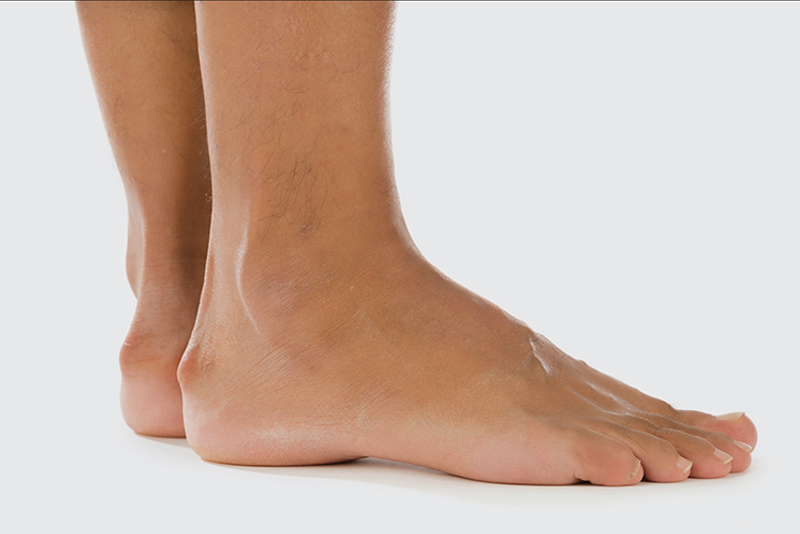The heel bone is the starting point of the Achilles tendon, which attaches the calf and its muscles to the heel. The heel handles an enormous amount of pressure daily so it’s not surprising that heel pain is one of the most common complaints in our podiatry clinic.
The causes of heel pain are various and below we have outlined some of the more common and not so common reasons. Pain is often felt in the heel directly or in the structures of the foot that surround the heel. But don’t be too concerned as in most cases, heel pain can be alleviated with some extra care and attention.
What causes heel pain?
As with many problems relating to our feet, the most common reasons for heel pain are overuse, over-stretching and poorly fitting shoes. These problems often lead to the following symptoms of heel pain:
Plantar fasciitis
Plantar fasciitis is the most common cause of heel pain. It is an inflammation of the plantar fascia, the band of tissue that runs underneath the foot forming the arch, connecting the heels to the toes. Plantar Fasciitis occurs through overuse and strain of the feet which causes small tears in the plantar fascia and therefore inflammation.
Heel spurs
A heel spur is a bony projection at the area where the plantar fascia attaches to the heel bone. They occur through constant and repetitive strain on the plantar fascia and muscles of the foot. Heel spurs themselves are not painful but they can cause pain when pulling on the planta fascia.
Plantar heel bursitis
The bursa are sacs that lines the joints allowing tendons and muscles to move easily. Bursitis is the inflammation of these bursa, caused by an abnormal gait or shoes that don’t have enough heel cushioning.
Heel bruise
Heel pain can also be caused by a simple heel bruise, from trauma or injury to the pad that protects the heel. A bruised heel may take two to three weeks to heal.
Severs disease
Severs disease is a common problem in children between 7-14 years of age and it is not actually a disease, just a painful condition of the heels associated with growing pains.
Achilles tendinitis
Achilles tendonitis is the inflammation of the Achilles tendon, the tendon that attaches your heel to your calf muscle. When exposed to excessive overuse, the tendon can be damaged and cause pain in the Achilles tendon around 2-5cms above the heel.
Nerve impingement
A small plantar nerve in the heel can become trapped and cause significant pain. Unlike plantar fasciitis, plantar nerve impingement causes chronic pain even when your feet are up.
Other causes – referred pain
There may be other causes of heel pain that may start from your ankles, knees, hips and back alignment. A professional assessment in our clinic will determine the cause and recommend the right sort of treatment which may also include other allied therapies.
Self-help – what you can do at home to alleviate heel pain
You can prevent heel pain by paying extra attention to your feet before and after exercise or activities that put pressure on your feet.
- Warm up before doing exercise with stretches
- Wear proper fitting shoes that support both your heel and arch
- Massage and stretch your plantar fascia after exercise to alleviate tension
- Massage and stretch your calves after exercise to alleviate tension in the Achilles tendon
- Maintaining a normal body weight as excess body weight places stress on your feet especially the heel
- Massage the soles of your feet after exercise and apply ice if necessary, to reduce inflammation
How we help you with heel pain
Heel pain should not be left untreated. Pay attention to the pain and how it begins and pull back from repetitive activities that are causing the pain. Enduring heel pain is never a good idea and we’d recommend getting off your feet, resting and applying ice packs. If this doesn’t help then pop into our clinic for a diagnosis and professional advice.
Some of the treatments we use for heel pain include:
Physical therapy – we’ll use strengthening and stretching exercises to improve muscle function and alleviate tension in the heel and surrounding areas. We massage your feet to release tightness and reduce inflammation and will also use Ultrasound therapy as part of the treatment if needed. We’ll teach you how to stretch and strengthen your feet at home to continue the healing process.
Athletic taping – we sometimes use athletic tape to help support both the heel and the plantar fascia to lessen the strain and pressure and prevent further heel pain.
Orthotics – we may recommend custom orthoses to support your arches and heel, to distributing the weight evenly over the foot. We’d assess your gait and standing posture to determine the type of custom orthoses you’d need.
Medication – we only suggest medication for temporary pain relief while we find the root cause of the heel pain and work on alleviating this.
Make an appointment to have your heel pain assessed
If you’re experiencing heel pain and you’ve done your home preventive exercises and resting, then we’d recommend you make an appointment with one of our podiatrists and have your heel pain looked at.
We’ll assess the structure of your foot, your gait and ask you about your daily activities to determine the cause and prevent further pain. We understand you want to get on with your favourite activities, so with our help, you’ll be back on your feet sooner than later.
Call us or make an appointment at one of our podiatry clinics located in Adelaide, Stirling and Mount Barker.
Sander Podiatry Adelaide – 08 8379 1456 (Greenhill Podiatry)
